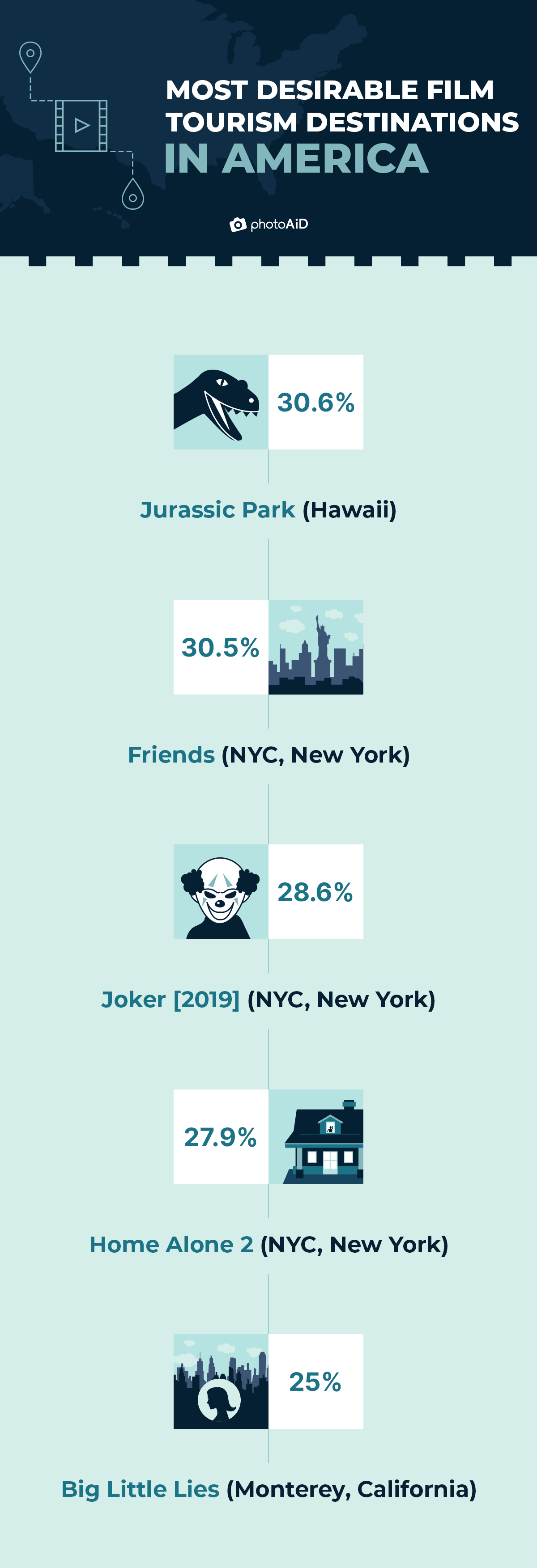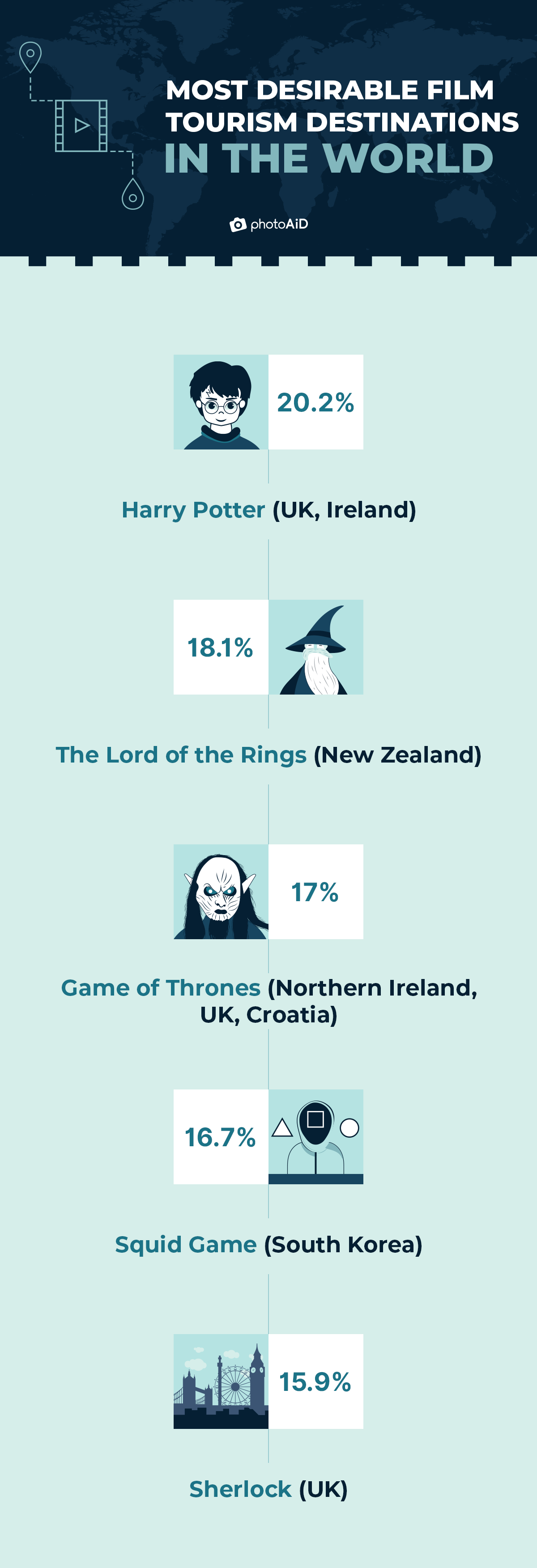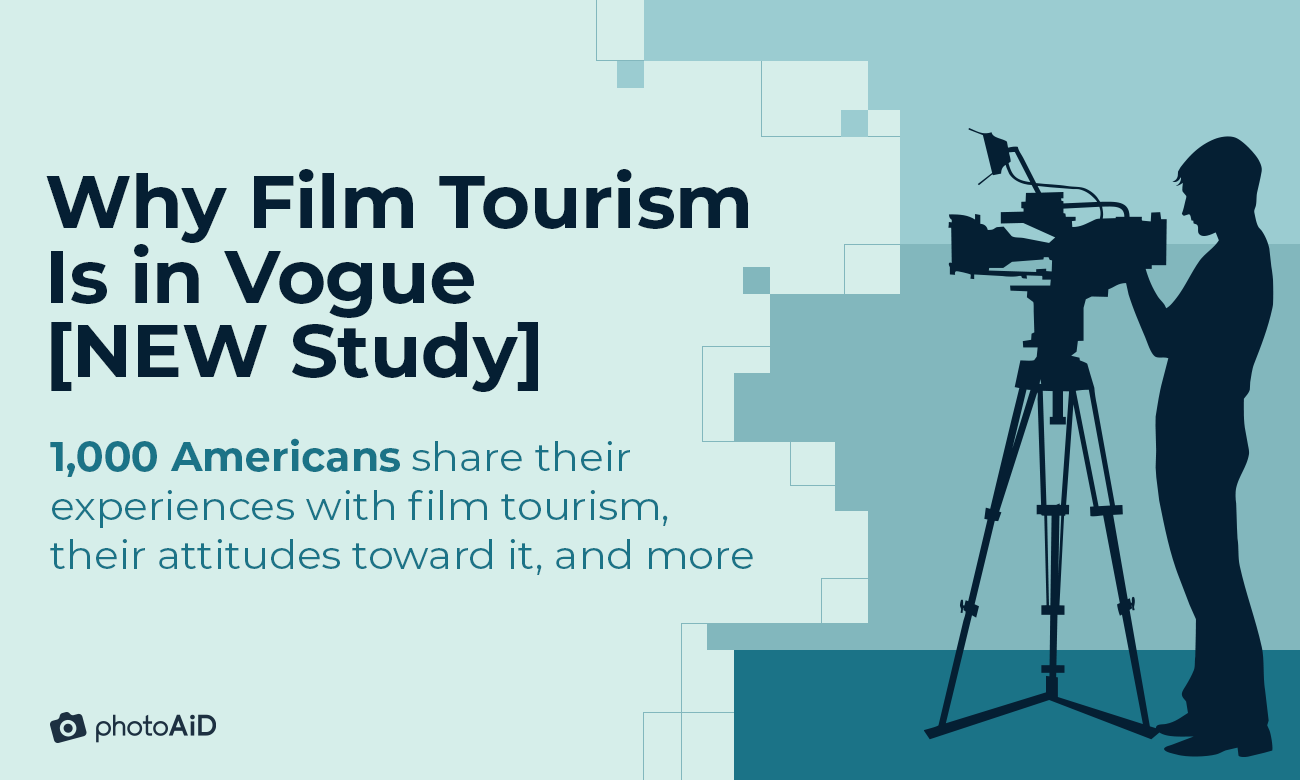We’ve all fallen in love with a TV show or movie at least once.
Whether it’s Harry Potter, The Walking Dead, or Breaking Bad, there’s something about getting sucked into a good story that makes you feel warm and fuzzy inside.
But—
Did you ever consider traveling to a place you saw on Netflix?
If so, you aren’t alone.
That’s because film tourism (also known as film-induced tourism, screen tourism, and set-jetting) has been all the rave lately, with more and more people planning vacations around their beloved shows and movies.
So at PhotoAiD, we’ve decided to reach out to 1,000+ Americans to unpack their experiences with this phenomenon, their attitudes toward it, and much more.
Let’s dive right in:
Key Takeaways

- 96% of Americans have visited places associated with their favorite television shows or movies at least once in their lifetime.
- 78% of travelers are likely or very likely to opt for TV- or movie-themed trips in 2023 and beyond.
- The most common reason to engage in film tourism (35%) is to enjoy an immersive experience that lets you live out shows’ or movies’ storylines and follow in the footsteps of famous characters.
- Lodging is the most frequently mentioned film tourism expense (60%), followed by transportation (53%) and sightseeing (50%).
- Globally, the UK and Ireland are the most desirable screen tourism destinations owing to the success of Harry Potter.
- Thanks to the Jurassic Park franchise, Hawaii was picked as the US’ most desirable film tourism destination, according to 31% of respondents.
- 68% of Americans have a negative or very negative attitude toward fellow travelers striking irreverent poses or otherwise misbehaving when visiting the sites of actual tragic events depicted in shows or movies.
Film Tourism Is Gaining Momentum
For starters, we wanted to gauge the popularity of film tourism in the US at the end of 2022.
It turns out 96% of Americans have visited places associated with their favorite television shows or movies. This includes locations and destinations, popular due to their appearance on TV or themed sites built upon the fictional world.
Wow.
Although we expected the number to be high, we had no idea it’d be THAT high.
It may be because we’re watching more TV than ever before, with the average person likely to stream 437 hours of content in 2023 (=18 full days).
Here’s also a look at the extent to which respondents’ favorite movie or show was a reason to visit a particular spot:
| It was the main reason | 44% |
| It had some influence | 39% |
| It had no influence | 17% |
At this point, we also decided to ask survey takers to rate their most recent screen tourism experience.
So—
About four in 10 Americans (42%) consider it positive, and 31% describe it as very positive. As a follow-up, we asked respondents how likely they are to pick one of their next vacation destinations based on their favorite TV show or movie in 2023 and beyond.
The results are in:
| Likely | 45% |
| Very likely | 33% |
| Neutral | 16% |
| Very unlikely | 5% |
| Unlikely | 2% |
As you can see, 78% of Americans are likely or very likely to opt for TV- or movie-themed trips in the upcoming years.
Thus, it’s not surprising that companies like Airbnb and Netflix have already started to capitalize on the opportunity.
The former has launched thematic accommodation options based on Scooby Doo, Moulin Rouge, and Queer Eye. In turn, Netflix partnered with the UN World Tourism Organization (UNWTO) to “help destinations realize the potential benefits of screen tourism.”
Even governmental bodies aren’t lagging.
In fact, the official “Visit Albuquerque” site makes it easy for Breaking Bad fans to plan location tours and visit popular spots, such as Los Pollos Hermanos, Walter White’s house, and the car wash.
That shows just how much the likes of HBO and Apple TV are changing the tourism industry and travelers’ habits.
Scroll on to see what’s fueling this trend.
Key Reasons to Engage in Screen Tourism
People travel for all sorts of reasons.
Some want to check off their travel bucket list. Others are looking to dive under the radar and escape it all.
Yet—
When it comes to film tourism, here are the TOP five motivators, according to our respondents (the text version is below, just in case):

| To emotionally immerse oneself in a place where the TV show/movie was filmed | 35% |
| To experience the city’s scenery shown in the movie or TV show | 34.9% |
| To visit restaurants featured in the movie or TV show | 34.4% |
| To discover a meaningful place with a story rather than visit a trendy destination | 33.9% |
| To visit a location one’s admired celebrity has once been to | 33.6% |
The data shows that the most common reason to engage in film tourism (35%) is to enjoy an immersive experience that lets you live out your favorite shows’ or movies’ storylines and follow in the footsteps of famous characters.
It’s closely followed by the desire “to experience the city’s scenery shown in the movie or TV show” at 34.9% and to visit depicted restaurants, as 34.4% of respondents indicated.
These make sense, particularly if you consider TV shows.
Their slow-paced plot progression, long runtime, and character development often foster a deep connection between the viewer and the story.
So—
It’s no wonder many people want to go and see the spots on their own.
Top Film Tourism Destinations, Ranked
So far, so good.
Now that we’ve answered some of the why questions, let’s move on to the where part.
To uncover the most desirable film tourism destinations in North America, we gave respondents a list of places famous because of a movie or TV show and asked them to indicate which one was their favorite OR which they’d like to visit the most.
Below are the results:

| Jurassic Park (Hawaii) | 30.6% |
| Friends (NYC, New York) | 30.5% |
| Joker [2019] (NYC, New York) | 28.6% |
| Home Alone 2 (NYC, New York) | 27.9% |
| Big Little Lies (Monterey, California) | 25% |
Thanks to the Jurassic Park franchise, Hawaii was picked as the most desirable film tourism destination in the US, according to 30.6% of respondents.
How does it translate into real numbers?
Consider this:
Jurassic World: Fallen Kingdom alone has given Hawaii’s economy a $31M boost and more than $6.9M in wages to 1,200+ Hawaii workers.
So you could say the movie has had a T-Rex-sized impact on the islands.
Now—
We also wanted to unveil the most desirable screen tourism destinations globally. Like last time, we gave respondents a hefty list of places and prompted them to make a pick.
See the TOP five results below:

| Harry Potter (UK, Ireland) | 20.2% |
| The Lord of the Rings (New Zealand) | 18.1% |
| Game of Thrones (Northern Ireland, UK, Croatia) | 17% |
| Squid Game (South Korea) | 16.7% |
| Sherlock (UK) | 15.9% |
The UK and Ireland took the cake as the most desirable screen tourism destinations globally (20.2%), thanks to Harry Potter. It’s followed by New Zealand courtesy of The Lord of the Rings trilogy. Northern Ireland, the UK, and Croatia close the top three owing to Game of Thrones’ success.
Needless to say, all the destinations saw a significant, lasting increase in demand after said movies and TV shows came out.
To this day, tourists take photos at London King’s Cross railway station, famous for featuring a fictional section known as platform 9¾ in Harry Potter and the Sorcerer’s Stone.
Biggest Expenses Associated with Screen Tourism
Travel isn’t exactly cheap these days.
A pilot shortage, COVID-19-induced demand for travel, and higher fuel prices have all contributed to the recent rise in tourism costs.
So much so that ~9 in 10 vacation-goers (88%) had to downgrade their vacation plans in 2022, according to one of our recent studies.
That’s why we wanted to ask the respondents about their biggest expenses regarding film tourism.
Below are the results:
| Lodging | 60% |
| Transportation | 53% |
| Sightseeing | 50% |
As you can see, lodging was the most frequently mentioned expense (60%), followed by transportation (53%) and sightseeing (50%).
So—
If you plan to fly thousands of miles to get epic Instagram snaps from Squid Game in South Korea, be prepared to open your wallet a little wider.
The Dark Side of Film Tourism
It’s no secret:
Many popular movies and TV shows depict or are based on true events. As a result, some locations can grow popular among travelers.
BBC’s Poldark is a good case in point.
While the series boosted Cornwall’s economy, influencing 14% of all visitors to the county, it also gave rise to the so-called “Poldark effect.”
The phenomenon caused bumper-to-bumper traffic making some communities feel unsafe, and potentially affected the sense of the Cornish identity.
So—
Our study also wanted to see if Americans know that film tourism can cause over-tourism to some of the most in-vogue destinations.
A total of 95% of respondents do.
Although we were pleasantly surprised by such a high number, it’s important to remember that awareness doesn’t always translate into action (after all, the “Poldark effect” came about for a reason).
Now, as our last question, we asked the survey participants about their attitude toward fellow travelers striking irreverent poses or otherwise misbehaving when visiting the sites of actual tragic events featured in a movie or TV show (e.g., Chornobyl).
Below are the results:
| Negative | 41% |
| Very negative | 27% |
| Neutral | 24% |
| Positive | 5% |
| Very positive | 4% |
The takeaway?
Always respect the site’s rules and only take pictures when allowed. Otherwise, you won’t only make others blow a fuse but also give film tourism a bad name.
Stacking It All Up
There you have it.
A comprehensive look at screen tourism to help you stay ahead of the curve.
Now—
Did you ever engage in film tourism? Which TV or movie universe would you want to travel to?
Let us know in the comments below.
Methodology
We conducted an online survey of 1,060 US respondents via a bespoke online polling tool in October 2022.
The respondents were 66.8% male and 33.2% female. 7.6% of respondents were 25 or younger, 70.01% were aged 26–38, 17.1% were aged 39–54, and 5.2% were 55 or older.
This survey has a confidence level of 95% and a margin of error of 3%. Given the gender and age makeup of our sample size, the study’s findings are statistically significant for the population at large.
This study was created through multiple research steps, crowdsourcing, and surveying. Data scientists reviewed all survey participants’ responses for quality control. The survey also had an attention-check question.
Fair Use Statement
Did our findings help you learn more about film tourism? If you believe your audience will be interested in this information, feel free to share it. Just remember to mention the source and link back to this page.
Sources
- Commisso D., “Here’s What Watching TV Looks Like for Americans Today”
- Ellison J., “How the Pandemic Propelled the Rise of Television Tourism”
- Globetrender, “Airbnb Unveils Scooby Doo, Queer Eye and Moulin Rouge Stays”
- Goel S., “Blockbuster Movies Create Booms for Tourism — and Headaches for Locals”
- Mason E., “‘Poldark’, ‘Peaky Blinders’ and 6 Historical TV Shows That Bring Tourists to Britain”
- Pitner D., “‘Jurassic World: Fallen Kingdom’ Had a Dinosaur-Sized Impact on Hawaii’s Economy”
- Tuclea C., Nistoreanu P., “How Film and Television Programs Can Promote Tourism and Increase the Competitiveness of Tourist Destinations”
- UNWTO, “UNWTO and Netflix Partner to Rethink Screen Tourism”
- Vayntraub A., “Average Person Expects to Stream This Many Different Movies or TV Shows Yearly”
- Visit Albuquerque, “Sightseeing in Albuquerque, New Mexico”
- Woolf M., “The Impact of Inflation on Tourism and Travel [2022 Study]”

As a Digital PR specialist and a member of the Society of Professional Journalists (SPJ), I have 5+ years of writing experience.
Over the course of my career, my work has garnered significant attention, with features in numerous prominent publications such as The New York Times, Forbes, Inc., Business Insider, Fast Company, Entrepreneur, BBC, TechRepublic, Glassdoor, and G2.









